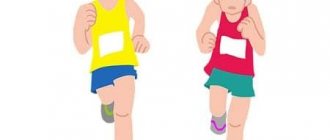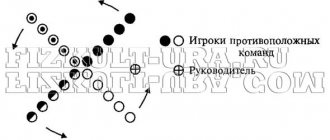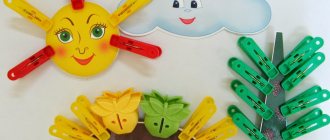Outline of joint activities in the middle group Topic: “Outdoor games with running while walking.”
Outline of joint activities in the middle group
Topic: "Outdoor games with running while walking."
Romanenko O.V., teacher
MADO CRR d/s No. 2 “Firefly”
Venue : physical training ground on the territory of the preschool educational institution
Program content:
Educational objectives: continue to introduce children to the rules of outdoor games, consolidate the skill of construction, use the competitive method of the outdoor game “Airplanes”
Developmental tasks: improve speed, agility; to train children in catching and dodging, to develop orientation in space, the ability to move in loose areas without bumping into each other.
Educational objectives: to cultivate interest in outdoor games; follow the rules of the game; develop the ability to act collectively; to form honesty, discipline, justice; contribute to maintaining good relations with each other.
Speech : train children in using counting rhymes for selection, develop the ability to pronounce words amicably during the game
Equipment: a colored box with an airplane inside, a beard, glasses and a hat, a fox cap, a bag with a bun, 2 chairs or hemp.
The course of joint motor activity.
Organizing time:
Game "Planes"
The teacher and the children walk onto the playground and there is a box with a toy inside on a chair.
-Children, look, what is this? (Box)
-What do you think is in it? (Children’s answers)
-Let's see. (The teacher opens and takes out the plane)
- Children, what is this? -
- That's right, the plane, but what does it do? (flies)
-Children, would you like to fly like airplanes? (Yes) Only we will have 2 teams: a boys team and a girls team.
Set landmarks.
-This is the boys' airfield, and this is the girls' airfield.
-According to my signal “ Get ready for flight!” We will circle with our arms bent at the elbows and start the engine. When I say: “Fly!” we will raise our arms to the sides and fly. At the signal “ Landing !” — everyone returns to their airfields. Who's faster, boys or girls?!
-Now let’s start the game (the game is played 2-3 times).
-We had a good flight, we returned to the airfields on time, now we need to refuel.
Breathing exercise “At a gas station”
-Legs slightly apart, move your arms from the chest down, say: “sh-sh-sh” (3 times)
Game "Grandfather Horn"
After the game “Planes,” the teacher tells the children to stand in a row near the stairs, lays a rope on the other side, puts on grandfather’s beard and picks up a wand. He walks around the site and limps and says:
-Hello children, do you recognize me? (Yes, grandpa is a horn)
-Children, can I sit on the chair, otherwise I was so tired while walking to you from the forest. And then we will play. You will run behind the rope, let’s see where it is?!
-Can you sing songs? (Yes)
-Well, sing me something then, and I’ll sit and listen to you sing.
Children sing a teaser: “Grandfather the horn, he ate the pie!”
“Grandfather-horn, he ate the pie!”
Grandfather gets up and starts catching them.
-Oh, what, tease your grandfather, I’ll catch up with you, I’ll catch you now! (they run across the platform behind the ropes and stop)
Plays 2 times.
Game "Kolobok"
The teacher takes off his beard after the game and tells the children:
-Guys, look what’s under the bush, it’s a bag and there’s something in it (children bring the bag). The bag is tightly tied and we can’t figure out what’s inside. Let's touch (children feel the object without opening the bag), what do you think it could be?) Different versions of the children are heard)
-I’ll try to open it and see what’s there?
-Look, this is... The children answer: “Kolobok”
-I wonder what he’s doing here, maybe he wants to play with us? (yes)
- I know one game called “Kolobok”. Let's play it.
The teacher tells the description of the game to the children.
-Listen, we need to use a counting rhyme to choose a fox, and all the other children will be koloboks.
Counting book: (choose a fox)
1,2,3,4,5 – we gathered to play
A magpie flew to us
And she told you to drive.
The teacher gives an example of how to use the counting rhyme correctly.
-Now, imagine that we are in the forest. The fox will sit on a chair on one half of the platform, and we will be on the other. We will walk along the platform in small steps, as if we were rolling through the forest, like a bun, and humming a song:
“I am a cheerful bun, I have a ruddy side,
I’m not afraid of anyone, I’m rolling along the path.”
-And when we approach the fox, we must say the following words:
"Oh, trouble, trouble, trouble,
The fox might eat me."
-And run away from the fox around the site in different directions, and whoever the fox hits must move away...
-We start the game, and the bun will watch as we play it and follow the rules. (The teacher puts the bun on a chair (stump))
The game begins. Plays 2 times.
After the game, a breathing exercise is performed.
Exercise “Tree in the Wind”
Initial position. Spread your legs a little.
Performance. While inhaling, we raise our hands up, while exhaling, we lower our hands.
-How does the wind make noise? (sh-sh-sh). (2-3 times).
- Well done guys.
- Guys, did you like playing? (Yes) - Let's go to our site and continue playing other new games.
Card index of outdoor games in the preparatory group: compiling it correctly!
Home and family February 4, 2014
Pupils of the preparatory group are future first-graders. It is important for them to strengthen their physical skills, practice responding on command, and practice agility.
That is why the card file of outdoor games in the preparatory group contains exercises that promote the comprehensive development and strengthening of the child’s strength and dexterity. In addition, we must not forget about the exciting side of games: story-based fun remains on par with non-plot fun.
From this article you will learn what outdoor games can be used in the preparatory group.
"Owl"
The card index of outdoor games in the preparatory group must contain this game. It is aimed at developing endurance and agility. The teacher chooses a driver, who becomes the Owl. In one of the corners of the site there will be an Owl's Nest.
The rest of the children run and frolic on the playground, pretending to be butterflies, beetles and other insects. After a certain period of time, the teacher without warning says: “Night!” Everyone should freeze in place in a motionless position. And the driver, Owl, flies out to hunt.
She flies slowly, watching to see if anyone is moving. If the Owl sees that someone has moved, she takes him to her nest. The teacher then says: “Day!” The players begin to spin, fly and buzz again.
The game can be repeated 2-3 times, then another driver is selected.
"Day and night"
The card file of outdoor games in the preparatory group should include this game, because It is aimed at developing the dexterity and physical health of children. The teacher divides the game participants into two teams - “Night” and “Day”. They live opposite each other.
A line is drawn in front of their houses, and another line is drawn in the middle. Teams line up one step before the line on both sides with their backs to each other. The teacher says: “Get ready!”, then gives a sign to the team that will catch.
For example, if the teacher said “Night”, the children from the second team run home, and the “Night” team catches up with them. You can only fish up to the line in front of the opposing team's house.
We repeat the game 5-6 times, you can call the same team twice in a row (to confuse the children), but in total both teams must catch the same number of times. The team that catches the most children wins.
Video on the topic
“Outdoor games for the integration of cognitive and motor activities of children in preschool educational institutions”
- February 10, 2015
Competition “My Pedagogical Initiative - 2014”
Nomination “Methodological work in preschool educational institutions”
In the system of preschool education, a large place is occupied by the problems of the need to apply integrative knowledge. Integrated education creates new conditions for the activities of teachers and students, and is an effective model for enhancing mental activity and developing teaching methods.
The integration approach, based on universality, unity and integrity, the use of the laws of child psychology, acts as the leading principle in modern preschool education, which makes it possible to provide conditions for cognitive activity, within the framework of a holistic process, where the child learns everything new from different points of view in different educational spheres .
The use of various forms and methods of integrated intellectual and motor development of preschoolers in the process of physical education gives us the opportunity to comprehensively develop preschoolers and at the same time strengthen the health of children. Also, the integration of motor and cognitive activities of preschool children allows: to increase the efficiency of physical education and health work and the quality of the educational process in preschool organizations; allows you to optimize the physical activity regime of children in preschool settings; has a positive effect on the psychophysical development and physical fitness of children.
This paper presents material on the use of various forms and methods of integrated intellectual and motor development of preschool children
Outdoor games
"Math Blanket"
Goal: to teach how to perform tasks using diagrams, solve arithmetic problems involving addition, and consolidate knowledge of geometric shapes and numbers.
1. There is a blanket on the floor with images of geometric shapes of different colors or numbers. Children receive cards - diagrams with a depicted route of movement along which they need to jump on two or one leg.
2. There are blankets on the floor with numbers on them. Children throw sandbags in different ways onto the blanket, then count the number of points scored.
"Wizards"
Goal: to consolidate knowledge of geometric shapes, develop spatial orientation and expressiveness of movements.
Children receive a rope with tied ends, grasp it with both hands and, following signals, form various geometric shapes (circle, square, triangle, rectangle, polygon).
"The Blind is a Guide"
Goal: to strengthen children’s ability to navigate in space and act on a signal.
There are objects and obstacles on the floor. You need to go through them to the other side. The player goes through the obstacles blindfolded, listening to the commands of another “guide” player. For example: Two steps to the right, four steps straight, step over, three steps to the left, crouch, crawl, stop, etc.
"Pinocchio"
Goal: to develop imagination, consolidate knowledge of geometric shapes, develop orientation in space.
Children sit cross-legged on the carpet with their eyes closed.
Educator: Imagine that your nose is a pencil. Draw for them...
Children draw geometric shapes with an imaginary pencil.
"Baskets"
Goal: to consolidate knowledge of geometric shapes, colors, numbers.
Children receive stickers on their T-shirts with different colored geometric shapes or numbers. Standing in pairs scattered, they form “baskets.” The driver catches up with the child, and he, running away, hides in the “basket”. Having run into the “basket”, the child names one of the children based on the image of the sticker. For example: “Red circle!” The one who was named now runs away from the driver. The driver must have time to put the player down, and the player again hides in the “basket”, calling any other player.
"Parachute"
Goal: to consolidate knowledge of geometric shapes, three-dimensional figures, and communication skills.
Children stand in a circle, holding a “parachute” in their hands. Below it are the “Dyenes Blocks” or numbers. The children simultaneously lift the “parachute” up, and one child, remembering what he needs to reach under the “parachute”, crawls up on all fours. Next, he takes his object, returning to his place, and names what he took.
Game with a parachute (Cuisenaire sticks)
Goal: learn to run in a circle, changing direction. Consolidate knowledge of numbers, develop the ability to identify, abstract, and name colors.
Children run around with a parachute. The music stops, the teacher shows a number card, and the named child takes out a colored stick (Cuisenaire's stick) from the parachute, which represents this number and says what color it is.
"Math hedgehog"
Goal: to consolidate knowledge of geometric shapes, colors, numbers, the ability to find a number by the number of characters corresponding to this number.
1. On the carpet there are hedgehogs depicting geometric shapes of different colors, and the children have mushrooms depicting the same shapes. Children, running around the hall in all directions, hold a mushroom in their hands. On command, the children find a hedgehog with the same shape as on a mushroom’s cap.
2. The same task with numbers, only the children are looking for the number on the hedgehog, which corresponds to the number of dots on the mushroom cap.
"Houses"
Goal: To consolidate children’s knowledge about the composition of numbers and the ability to act on a signal.
There are houses on the carpet, children run or perform other movements with a number in their hand. At the signal, they find a free window for their number, which, when added to another number, indicates the composition of the number on the roof of the house. A complication for the game is when children, at a signal, look for a mate and together put their numbers in the empty windows, which together indicate the composition of the number on the roof of the house.
"Math Track"
Goal: to consolidate children’s knowledge of geometric shapes and colors, and the ability to navigate in space.
On the floor there is a path of soft geometric shapes of different colors. Children walk or jump on them, in accordance with the tasks. You can complete tasks by moving along geometric shapes using diagrams.
Application
Author: Rebrova N.A., physical education instructor at MBDOU kindergarten No. 49 of combined type, Odintsovo district, Moscow region.


